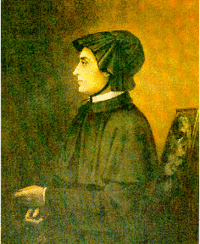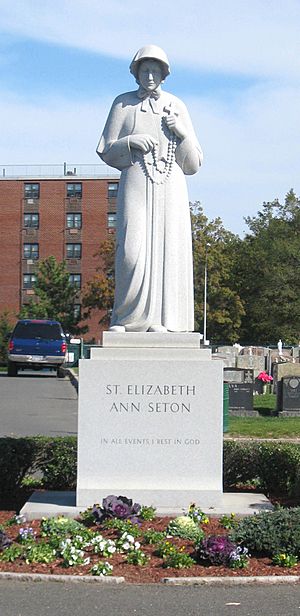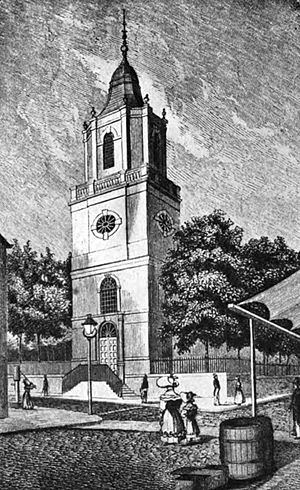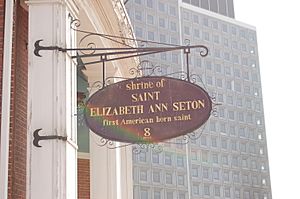Elizabeth Ann Seton facts for kids
Quick facts for kids SaintElizabeth Ann Seton S.C. |
|
|---|---|
 |
|
| Widow, Religious, Foundress, Educator | |
| Born | Elizabeth Ann Bayley August 28, 1774 New York City, Province of New York, British America |
| Died | January 4, 1821 (aged 46) Emmitsburg, Maryland, United States |
| Venerated in | Catholic Church, Episcopal Church (United States) |
| Beatified | March 17, 1963, by Pope John XXIII |
| Canonized | September 14, 1975, by Pope Paul VI |
| Major shrine | National Shrine of St. Elizabeth Ann Seton, Emmitsburg, Maryland (where her remains are entombed); Shrine of St. Elizabeth Ann Bayley Seton at 9 State Street in New York City (site of her former residence) |
| Feast | January 4 |
| Patronage | Catholic Schools; seafarers; widows; Shreveport, Louisiana; and the State of Maryland |
Elizabeth Ann Bayley Seton (August 28, 1774 – January 4, 1821) was an important Catholic religious sister and teacher in the United States. She is known for helping to start the country's parochial school system. After she passed away, she became the first person born in what would become the United States to be officially recognized as a saint by the Catholic Church. This happened on September 14, 1975.
Elizabeth Ann Seton also opened the first Catholic girls' school in the nation. It was located in Emmitsburg, Maryland. There, she also started the first American group of religious sisters, called the Sisters of Charity.
Contents
Biography of Elizabeth Ann Seton
Her Early Life and Family
Elizabeth Ann Bayley was born on August 28, 1774, in New York City. Her parents, Richard Bayley and Catherine Charlton, were well-known in society. Her father was a surgeon and a Health Officer for the Port of New York. He helped many people, especially during yellow fever outbreaks. He also taught anatomy at Columbia College.
Elizabeth's mother died when Elizabeth was only three years old. Her father then married Charlotte Amelia Barclay. Elizabeth's stepmother often took her to visit poor families to give them food and other items. This taught Elizabeth about helping others.
Elizabeth's parents separated, and she and her older sister lived with their uncle for a time. Elizabeth loved nature, poetry, and music. She also wrote in her journals about her religious thoughts. She could speak French, play music well, and was a good horse rider.
Marriage and Becoming a Mother
On January 25, 1794, when she was 19, Elizabeth married William Magee Seton. He was a wealthy businessman. His family was from Scotland and had moved to New York. William and his brother worked in a company that imported and exported goods.
Elizabeth and William lived in a nice house on Wall Street in New York City. They were part of the important social scene. They went to Trinity Episcopal Church. Elizabeth was very religious and helped her sister-in-law care for sick and dying people. She also helped start a group called The Society for the Relief of Poor Widows with Small Children in 1797.
The Seton family faced financial problems before the War of 1812. Elizabeth and William took in William's six younger brothers and sisters. They also had five children of their own: Anna Maria, William II, Richard, Catherine, and Rebecca Mary. This meant they needed a bigger home.
Becoming a Widow and Converting to Catholicism

A conflict between the United States and France (called the Quasi-War) caused problems for American ships. William Seton's business lost money, and he went bankrupt. The family lost their home. William also suffered from tuberculosis, a serious illness. His doctors sent him to Italy for a warmer climate. Elizabeth and their oldest daughter went with him.
They had to stay in quarantine for a month when they arrived in Italy. This was because officials worried they might have brought yellow fever from New York. William died on December 27, 1803, and was buried in Italy. Elizabeth and Anna Maria were cared for by William's business partners, the Filicchi family. They learned about the Catholic faith from them.
When Elizabeth returned to New York, she joined the Catholic Church on March 14, 1805. She was received by Matthew O'Brien at St. Peter's Church. This was the only Catholic church in the city at the time. A year later, she received the sacrament of confirmation from Bishop John Carroll. He was the only Catholic bishop in the country.
To support her children, Elizabeth opened a school for young ladies. However, when people found out she had become Catholic, many parents took their daughters out of her school.
In 1807, Elizabeth met a priest named Louis William Valentine Dubourg. He was part of a French religious group called the Sulpician Fathers. They had come to the United States to escape religious problems in France. Father Dubourg had a dream of starting a religious school for Catholic children in the new nation.
Starting a New Religious Community
After facing many challenges, Elizabeth accepted the Sulpicians' invitation in 1809. She moved to Emmitsburg, Maryland. A year later, she opened the Saint Joseph's Academy and Free School. This school was for Catholic girls. It was made possible by money from Samuel Sutherland Cooper.
On July 31, Elizabeth started a religious community in Emmitsburg. This group was dedicated to helping poor children. It was the first group of religious sisters founded in the United States. Their school was also the first free Catholic school in America. This small beginning led to the start of the Catholic school system in the United States. The group was first called the Sisters of Charity of St. Joseph's. From then on, Elizabeth became known as "Mother Seton." In 1811, the sisters began following the rules of the Daughters of Charity. This group was started in France by Vincent de Paul and Louise de Marillac.
Later Life and Death
Mother Seton spent the rest of her life leading and growing the new group of sisters. She was known as a charming and educated lady. Even though she had connections to New York society, she chose to dedicate her life to her religious calling and helping others. She faced difficulties like misunderstandings and the deaths of her two daughters and other loved ones.
Elizabeth Ann Seton died on January 4, 1821, when she was 46 years old. Today, her remains are buried in the National Shrine of St. Elizabeth Ann Seton in Emmitsburg, Maryland.
Her Lasting Legacy

By 1830, the Sisters of Charity of St. Joseph's were running orphanages and schools. They had spread as far west as Cincinnati and New Orleans. They also started the first hospital west of the Mississippi River in St. Louis.
Elizabeth Ann Seton had wanted her community to join the Daughters of Charity of St. Vincent de Paul in France. However, a trade ban with France during the Napoleonic Wars prevented this. Decades later, in 1850, the Emmitsburg community joined the Daughters of Charity. This made them the first American branch, just as Mother Seton had hoped.
Today, six different religious groups can trace their beginnings back to the Sisters of Charity in Emmitsburg. These groups are located in New York City; Cincinnati, Ohio; Halifax, Nova Scotia; Convent Station, New Jersey; and Greensburg, Pennsylvania. The community in Convent Station started the Academy of Saint Elizabeth in 1860 and the College of Saint Elizabeth in 1899.
Elizabeth Ann Seton has also been honored in the National Women's Hall of Fame.
Becoming a Saint: Canonization
In 1952, a young girl named Ann O'Neil was healed from leukemia. This healing was believed to be a miracle that happened because a nun prayed to Elizabeth Ann Seton. This miracle helped Elizabeth Ann Seton to be beatified by Pope John XXIII on March 17, 1963. The Pope said that she "sowed a seed in America which by Divine Grace grew into a large tree."
Pope Paul VI officially made Elizabeth Ann Seton a saint on September 14, 1975. This ceremony took place in St. Peter's Square. Pope Paul VI said, "Elizabeth Ann Seton is a saint. St. Elizabeth Ann Seton is an American. All of us say this with special joy... Elizabeth Ann Seton was wholly American! Rejoice for your glorious daughter." The miracle that led to her becoming a saint involved the healing of a man in 1963. He was very sick with meningitis and encephalitis and was expected to die.
Seton's feast day is January 4. This is the day she died. She is the patron saint of seafarers and widows.
Elizabeth Ann Seton is also honored on the liturgical calendar of the Episcopal Church in the United States of America on January 4.
Places Named After Her
Hospitals
The Daughters of Charity Health Network opened Bayley Seton Hospital in 1980. It is located in Stapleton, Staten Island, New York.
Schools
Mother Seton School in Emmitsburg, Maryland, is a school that continues the work of Saint Joseph's Academy and Free School. It is a private elementary school for students from pre-kindergarten to 8th grade.
In the Philippines, the Elizabeth Seton School in Las Piñas opened in 1975. It is the largest Catholic school in that city.
Elizabeth Seton College in Yonkers, New York, helped young people continue their education. It joined with Iona College in 1989.
Seton Hall College (now Seton Hall University) in South Orange, New Jersey, was founded in 1856 by Elizabeth's nephew, Bishop James Roosevelt Bayley. He named it after his aunt. Seton Hall Prep is a high school for boys in West Orange, New Jersey.
The Seton Hill Schools (now part of Seton Hill University) were named for Seton. They were founded by the Sisters of Charity in 1885. The university is in Greensburg, Pennsylvania.
Elizabeth Seton High School is an all-girls Catholic school in Bladensburg, Maryland. It is named in her honor.
Other schools named after her include:
- Seton Academy (1963–2016) in South Holland, Illinois.
- Seton Catholic High School (1900–2007) in Pittston, Pennsylvania.
- Seton School in Manassas, Virginia.
- Seton Catholic School (K-8) in Hudson, Ohio.
The College of Mount Saint Vincent in Bronx, New York, was founded by the Sisters of Charity of New York. It has the Elizabeth Seton Library and a building called Seton Hall.
Niagara University in Lewiston, New York, also has a dormitory building named Seton Hall.
Churches
Many Catholic churches are named after Elizabeth Ann Seton. The first church named in her honor, Blessed Elizabeth Ann Seton, was built in 1963 in Shrub Oak, New York.
After she became a saint in 1975, St. Elizabeth Ann Seton Catholic Church was built in Crofton, Maryland. This is in the same area where she founded her school.
As of 2018, there are churches named after her in over 40 states in the United States, as well as in Canada and Italy.
Charities
Seton Villa is a small charity in Sydney, Australia. It was started in 1966 by the Daughters of Charity of St Vincent de Paul. It provides housing for women with disabilities.
See also
In Spanish: Isabel Ana Seton para niños





